
The cooler evenings signify that fall is creeping up on us here in Virginia. And along about this time of year, I just love selecting and planting Spring-flowering bulbs. The anticipation of seeing those little green Spring bulb shoots peeking up through the bare winter soil or icy white snow cover just makes it all worthwhile.

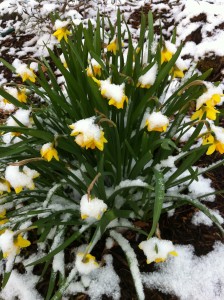
It’s A Gardener’s Delight to plant bulbs and wait for them to grow and flower. Then we start the whole process again next year!
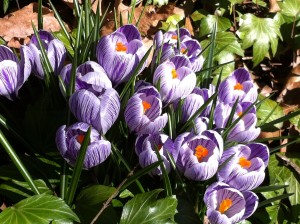
A good reference book for successful bulb planting is The Complete Practical Handbook of Garden Bulbs by Kathy Brown.
Let me help provide you with some flowering bulb suggestions for your garden.
Choosing Spring-flowering bulbs
Daffodils, tulips, crocuses, and hyacinths are the most popular Spring-flowering bulbs. Daffodils and crocuses are generally deer-resistant bulbs. Tulips are mostly deer candy, so avoid planting tulips in an area that is accessible by deer. Snowdrops can peek up through the snow and bloom much earlier than the other Spring-flowering bulbs.
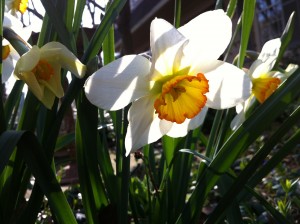
Daffodils come in petal shades ranging from white to cream to yellow with center colors ranging from deep salmon to orange to yellow to cream. I just love the little tete-a-tetes with their tiny little flowers. Tete-a-tetes are some of the first bulbs to bloom in Spring. Some lilies will bloom in Spring — check with your local garden center for a list of lilies that will bloom early in your area.
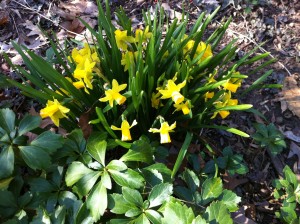
Tulip flowers come in all colors from whites to yellows to oranges to apricots to pinks to reds to violets to deep plums that are almost black. There’s even a green flower variety. There are so many tulip types and colors that you could plant 20 different types/colors and still have hundreds to choose from. Some tulip flowers are pointed, some are rounded, some are a solid color, some are mottled, some are striped. Some tulip flowers have smooth edges and others are feathery such as the “parrot” tulips. One of the recent bulb catalogs that I’ve received has dedicated its first 60 pages to tulips alone.
Crocuses’ color palette extends to whites, yellows, purples and combinations of each! Crocus blooms will last a few weeks and their green and white leaves will act as a nice groundcover for several months.
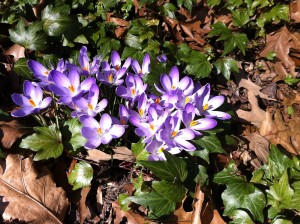
Hyacinths tend to range from pinks to purples to blues to whites to yellows. The grape hyacinth has a smaller flower that is shaped more like a cone.
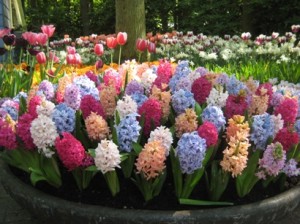

Be careful of low-priced large-volume bulb mixes. They might appear to save you money up-front, but in the long run, the plentiful mixes may be full of lesser quality bulbs. Choose heavy bulbs that feel solid rather than those that feel light and dried out. A bulb planter is a valuable tool that will help you carve out just the correct size hole for bulbs.
In initially preparing your bulb beds, you may wish to use a tiller or cultivator to break up heavier packed soil for easier planting. A metal rake or hoe can work just as well if your soil is loose.
Keeping critters away from your bulbs
Over the years, I’ve mostly planted daffodils and jonquils as well as some crocuses. The squirrels in my locale have regularly dug up and eaten the tulips that I’ve planted. This is akin to the little voles that love to eat my hosta roots and nibs. I gave up planting tulip bulbs in the ground in favor of pots. Planting bulbs in pots won’t stop the squirrels from digging them up so I use an inch-thick layer of pea gravel on top of the soil. The bulbs poke through the gravel just fine and the squirrels don’t like to dig through the gravel.
To keep voles and other critters at bay when planting bulbs in the ground, you can use a sharp gravel called Volebloc around the bulbs. Put a small shovelful around the perimeter inside the hole that you have dug and mix the Volebloc into the dirt as you are planting the bulbs. The voles won’t want to chew through the sharp gravelly area, and will avoid your bulbs.
You can also use blood meal which is good for the bulbs yet its strong odor repels deer and squirrels and other critters that might want to dig up your newly planted bulb beds.
And, finally, you can make a “box” out of chicken wire to keep voles and other critters from digging up and eating your bulbs. Just plant your bulbs in the box in a prepared hole to the appropriate depth and wire the top shut. Cover the box with dirt. The chicken wire box is also convenient if you wish to dig and store your bulbs during the summer months.
A few bulb-planting basics
Bulbs are best planted en masse. Buying 10 bulbs for a large flowerbed won’t fill it out. Try purchasing 100 or more and planting them together for a stunning display. Additionally, you can try naturalizing your bulbs. Naturalizing is essentially scattering the bulbs on the ground and planting them wherever they fall, just as Mother Nature would plant them. And before I forget to remind you, in the Northern regions of the US, try to get your bulbs into the ground by Thanksgiving so they have adequate time to chill before Spring.
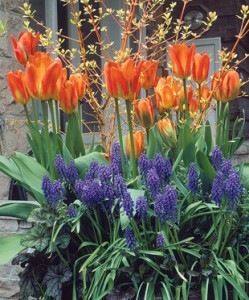
You may want to add some bone meal fertilizer to the soil around your bulbs while you are planting.
Forcing bulbs indoors for early bloom
Paperwhites and other bulbs can be forced indoors for early bloom during the cold winter months. All that you need is a shallow basin or pot, some pebbles or soil, some bulbs, and water, and you can have flowering bulbs in a short period. Most gardeners that I know will want their paperwhites to be in flower around the holidays. Tulips and hyacinths are also popular for indoor forcing.
One of my favorite books for bulb forcing indoors is by Katherine Whiteside. The author also provides steps to force other blooms indoors such as flowering tree and shrub branches and even houseplants. The book is not widely available anymore, yet you may be able to obtain a copy below:
Overall, probably my favorite types of flowering plants, besides my perennials, are my Spring-flowering bulbs. Again, it’s that anticipation over the winter when the rest of the garden is napping that so excites me. When will the crocuses peek through? When will I see the tips of my daffodil leaves pushing up through the snow? These are the signs of the next growing season and rebirth!
What’s your favorite flowering bulb? What bulbs are you planting in your garden this fall? What bulbs have you already planted that have performed well over the years?

++++++++++++++++++++++++++++++++++++++++++++++++++++++++++++++++++++++++++



Leave a Reply
You must be logged in to post a comment.